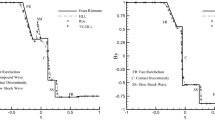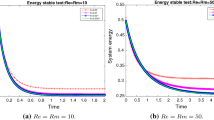Abstract
This work develops a new monolithic strategy for magnetohydrodynamics based on a continuous velocity–pressure formulation. The magnetic field is interpolated in the same way as the velocity field, and the entire formulation is within a nodal finite-element framework. The velocity and pressure interpolations are chosen so that they satisfy the Babuska–Brezzi (BB) conditions. In most of the existing formulations, a stabilized formulation is used that requires a stabilization term, and some associated mesh-dependent parameters that need to be adjusted. In contrast, no such parameters need to be adjusted in the current formulation, making it more user-friendly and robust. Both transient and steady-state formulations are developed for two- and three-dimensional geometries. An exact linearization of the monolithic strategy ensures that rapid (quadratic) convergence is achieved within each time (or load) step, while the stable nature of the interpolations used ensures that no instabilities arise in the solution. An existing analytical solution is corrected. The coarse mesh accuracy is shown to be better compared with other existing strategies in several benchmark problems, showing that the developed formulation is both robust and efficient.














Similar content being viewed by others
Abbreviations
- \(\alpha \) :
-
parameter in the generalized trapezoidal rule
- \({\varvec{b}}\) :
-
body force per unit mass
- \({{\varvec{B}}}\) :
-
magnetic induction
- \({\mathbb {C}}\) :
-
material constitutive tensor
- \({\varvec{D}}\) :
-
electric displacement
- \({\varvec{D}}_c\) :
-
rate of deformation tensor
- \({\varvec{E}}\) :
-
electric field
- \(\epsilon \) :
-
electric permittivity
- \(\epsilon _0, \epsilon _r\) :
-
\(\epsilon \) of vacuum, relative \(\epsilon \)
- \(\Gamma \) :
-
boundary
- \({{\mathrm{Ha}}}\) :
-
Hartman number
- \({\varvec{H}}\) :
-
magnetic field
- \({\varvec{j}}\) :
-
current density
- \(\mu \) :
-
magnetic permeability
- \(\mu _0\), \(\mu _r\) :
-
\(\mu \) of vacuum, relative \(\mu \)
- \(\mu _{\nu }\) :
-
fluid dynamic viscosity
- \({\varvec{n}}\) :
-
unit normal vector
- \(\nu \) :
-
kinematic viscosity
- \(\varOmega \) :
-
domain
- p :
-
fluid pressure
- \({\mathrm {Re}}\) :
-
Reynolds number
- \({\mathrm {Re}}_{\mathrm{m}}\) :
-
magnetic Reynolds number
- \(\rho \) :
-
fluid density
- \(\rho _c\) :
-
charge density
- \(\sigma \) :
-
conductivity
- t :
-
time
- \({\varvec{t}}\) :
-
traction vector acting on the surface
- \(t_{\Delta }\) :
-
time step in the transient strategy
- \({\varvec{\tau }}\) :
-
Cauchy stress tensor
- \({\varvec{u}}\) :
-
fluid velocity
- \(\dot{<\_>}\) :
-
Derivative of \(<\_>\) with respect to time
- \(\hat{<\_>}\) :
-
Discretized nodal values of \(<\_>\)
- \(<\_>_{\delta }\) :
-
Variation of \(<\_>\)
- \(<\_>_{\Delta }\) :
-
Increment of \(<\_>\)
- \(<\_>^{n}\) :
-
\(<\_>\) at time \(t_n\)
- \(<\_>^{k}\) :
-
\(<\_>\) at \(k^{\mathrm{th}}\) iteration at time \(t_{n+1}\)
References
Sterl A 1990 Numerical simulation of liquid-metal MHD flows in rectangular ducts. J. Fluid Mech. 216: 161–191
Hua T Q and Walker J S 1995 MHD flow in rectangular ducts with inclined non-uniform transverse magnetic field. Fusion Eng. Des. 27: 703–710
Borghi C A, Cristofolini A and Minak G 1996 Numerical methods for the solution of the electrodynamics in magnetohydrodynamic flows. IEEE Trans. Magn. 32(3): 1010–1013
Farahbakhsh I and Ghassemi H 2010 Numerical investigation of the Lorentz force effect on the vortex transfiguration in a two-dimensional lid-driven cavity. Proc. Inst. Mech. Eng. Part C: J. Mech. Eng. Sci. 224(6): 1217–1230
Peterson J S 1988 On the finite element approximation of incompressible flows of an electrically conducting fluid. Numer. Methods Partial Differ. Equ. 4: 57–68
Morley N B , Smolentsev S, Munipalli R, Ni M J, Gao D and Abdou M 2004 Progress on the modeling of liquid metal, free surface, MHD flows for fusion liquid walls. Fusion Eng. Des. 72: 3–34
Shakeri F and Dehghan M 2011 A finite volume spectral element method for solving magnetohydrodynamic (MHD) equations. Appl. Numer. Math. 61: 1–23
Verardi S L L and Cardoso J R 1998 A solution of two-dimensional magnetohydrodynamic flow using the finite element method. IEEE Trans. Magn. 34(5): 3134–3137
Planas R, Badia S and Codina R 2011 Approximation of the inductionless MHD problem using a stabilized finite element method. J. Comput. Phys. 230: 2977–2996
Boffi D, Brezzi F and Fortin M 2013 Mixed finite elements and applications. Berlin: Springer
Salah N B, Soulaimani A and Habashi W G 2001 A finite element method for magneto-hydrodynamics. Comput. Methods Appl. Mech. Eng. 190: 5867–5892
Salah N B 1999 A finite element method for the fully coupled magneto-hydrodynamics. PhD Thesis, Concordia University, Montreal, Canada
Salah N B, Soulaimani A, Habashi W G and Fortin M 1999 A conservative stabilized finite element method for the magneto-hydrodynamic equations. Int. J. Numer. Methods Fluids 29: 535–554
Shadid J N, Pawlowski R P, Banks J W, Chacn L, Lin P T and Tuminaro R S 2010 Towards a scalable fully-implicit fully-coupled resistive MHD formulation with stabilized FE methods. J. Comput. Phys. 229: 7649–7671
Nesliturk A I and Tezer-Sezgin M 2006 Finite element method solution of electrically driven magnetohydrodynamic flow. J. Comput. Appl. Math. 192: 339–352
Guermond J L, Lorat J and Nore C 2003 A new finite element method for magneto-dynamical problems: two-dimensional results. Eur. J. Mech. B Fluids 22: 555–579
Codina R and Silva N H 2006 Stabilized finite element approximation of the stationary magneto-hydrodynamics equations. Comput. Mech. 38: 344–355
Gerbeau J F 2000 A stabilized finite element method for the incompressible magnetohydrodynamic equations. Numer. Math. 87: 83–111
Schotzau D 2004 Mixed finite element methods for stationary incompressible magnetohydrodynamics. Numer. Math. 96: 771–800
Zhang G, He Y and Yang D 2014 Analysis of coupling iterations based on the finite element method for stationary magnetohydrodynamics on a general domain. Comput. Math. Appl. 68: 770–788
Greif C, Li D, Schtzau D and Wei X 2010 A mixed finite element method with exactly divergence-free velocities for incompressible magnetohydrodynamics. Comput. Methods Appl. Mech. Eng. 199: 2840–2855
Jin D, Ledger P D and Gil A J 2014 An hp-fem framework for the simulation of electrostrictive and magnetostrictive materials. Comput. Struct. 133: 131–148
Jin D, Ledger P D and Gil A J 2016 hp-Finite element solution of coupled stationary magnetohydrodynamics problems including magnetostrictive effects. Comput. Struct. 164: 161–180
Jog C S and Kumar R 2010 Shortcomings of discontinuous-pressure finite element methods on a class of transient problems. Int. J. Numer. Methods Fluids 62: 313–326
Davidson P A 1990 An introduction to magnetohydrodynamics. Cambridge: Cambridge University Press
Bardi I, Biro O and Preis K 1991 Finite element scheme for 3D cavities without spurious modes. IEEE Trans. Magn. 27: 4036–4039
Jog C S and Nandy A 2014 Mixed finite elements for electromagnetic analysis. Comput. Math. Appl. 68: 887–902
Nandy A and Jog C S 2016 An amplitude finite element formulation for electromagnetic radiation and scattering. Comput. Math. Appl. 71: 1364–1391
Gupta A 2000 WSMP: Watson sparse matrix package part II—direct solution of general sparse systems. IBM Research Report RC 21888 (98472)
Gupta A 2002 Recent advances in direct methods for solving unsymmetric sparse systems of linear equations. ACM Trans. Math. Softw. 28(3): 301–324
Moreau R 1990 Magnetohydrodynamics. Dordrecht: Springer
Moffatt H K 1983 Magnetic field generation in electrically conducting fluids. Cambridge: Cambridge University Press
Hunt J C R 1965 Magnetohydrodynamic flow in rectangular ducts. J. Fluid Mech. 21(4): 577–590
Author information
Authors and Affiliations
Corresponding author
Rights and permissions
About this article
Cite this article
Nandy, A., Jog, C.S. A monolithic finite-element formulation for magnetohydrodynamics. Sādhanā 43, 151 (2018). https://doi.org/10.1007/s12046-018-0905-z
Received:
Revised:
Accepted:
Published:
DOI: https://doi.org/10.1007/s12046-018-0905-z




